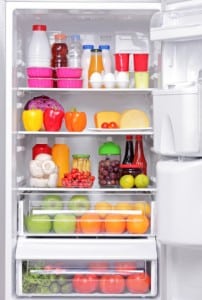 Your refrigerator may be the most neglected part of your kitchen. The dishes likely receive the most attention, followed by the kitchen surfaces such as the countertops and stovetop. The sink is probably cleaned often as well.
Your refrigerator may be the most neglected part of your kitchen. The dishes likely receive the most attention, followed by the kitchen surfaces such as the countertops and stovetop. The sink is probably cleaned often as well.
But your refrigerator, the place where the majority of your food is stored, is often forgotten. It usually takes a significant event, such as your refrigerator breaking, or a move out of your house or apartment for you to think about cleaning it. But cleaning your fridge is one of the most important things you can do in your home to reduce the risk of food borne illness.
If you manage a restaurant, you surely understand the importance of a clean refrigerator for the health and safety of your restaurant patrons. We’ll talk later about similar steps you can take in your home to regularly maintain your fridge. But first, here is the best method for cleaning your refrigerator.
How to Clean Your Fridge
What you’ll need:
- An ice chest
- A bag of ice
- A mild dish soap
- A medium-sized bucket
- Cleaning gloves
- All-purpose kitchen cleaner
- Your bathtub
Step 1: Turn off your fridge.
When you’re ready to clean the fridge, turn it off or unplug it. You will spend a lot of time with the doors open and do not want to waste any energy.
Step 2: Remove everything.
Remove everything from your refrigerator and start sorting. Ruthlessly get rid of any food items that might possibly be expired (when it doubt, throw it out! It’s not worth the risk.), as well as any food items that have not been used in awhile and are not likely to be used again anytime soon. Should you need that item again, you can always buy a fresh one.
Take the garbage out immediately. Place on ice in your ice chest everything that made the cut.
Step 3: Remove and soak drawers and shelves.
Anything that can be removed should be removed. Soak drawers and shelves in warm, soapy water made with dish soap (never bleach). Your shelves are likely too big for a bucket, so soak them in your bathtub.
Step 4: Wipe down all interior surfaces.
Now the real work begins. Spray all interior and exterior fridge surfaces with an all-purpose cleaner that is safe for use in kitchens and on surfaces that come into contact with food. Alternatively, use a mixture of baking soda and water. Then scrub the surface as needed with a microfiber rag or the rough side of a sponge. Rinse with clean, fresh water.
Step 5: Don’t forget the outside of the fridge!
Your door handles are likely one of the dirtiest surfaces in your kitchen because cooks are often in and out of the fridge during food preparation. Give the handles and the rest of the fridge exterior a good scrub using a safe disinfecting cleaner.
Step 6: Clean the door seals.
Don’t forget the door seals, usually full of hidden grime, dust, and food particles. Use a rag or a toothbrush to clean these hard-to-reach crevices.
Step 7: Clean the coils and vents.
Last but not least, carefully pull your refrigerator out from the wall (make sure it’s unplugged first!). Use the brush attachment on your vacuum to gently clean all dust from the coils behind your fridge. If your fridge has vents at the very bottom of the front of the fridge, clean those out with a vacuum or a warm cloth.
Step 8: After drying, replace everything.
Let the fridge air-dry for as long as needed. Turn your refrigerator back on and do not place food back in the refrigerator until it is back at a safe temperature.
How Often Should You Clean Your Fridge?
Every 2 or 3 months, your fridge should get a good, deep clean like the one described above. Create a reminder in your calendar or resolve to do your deep clean with the changing of each season.
Every month, go through and remove all expired food that’s cluttering your fridge. In addition, use disinfecting wipes or an all-purpose cleaner to wipe down high-traffic areas such as door handles, the front of shelves, or any other areas that need it.
Maintaining Your Clean Fridge
Now that your fridge is squeaky clean, you’ll want to keep it that way, or at least start a few easy habits to make it easier to clean next time. Here are a few tips:
- Wipe condiments and salad dressing containers with a warm rag after each use and before returning to the fridge. This little habit will go a long way!
- Take a tip from the restaurant biz and label everything in your fridge with the date. This will help you know when it’s time to throw things away.
- Clean up messes as you make them. It helps to keep some disinfecting wipes handy so that cleaning is quick and easy.
Keeping Your Fridge Smelling Fresh
Refrigerator odors are a common problem but an easy one to fix. Simply keep an open box of baking soda in the refrigerator. This will absorb odors and help keep your fridge smelling fresh.
For heavy-duty stenches, place dry, unused coffee grounds on a plate or bowl and put it in the fridge. Your fridge will smell like coffee for a few days, but after that the coffee smell will be gone along with other undesirable odors.
Performing this deep clean on a regular basis will help ensure not only that your fridge looks and smells fresh, but that it is also free of bacteria and germs that can be a health risk to you and your family.
Sources: http://theweek.com/article/index/268178/15-tips-for-a-squeaky-clean-fridge





